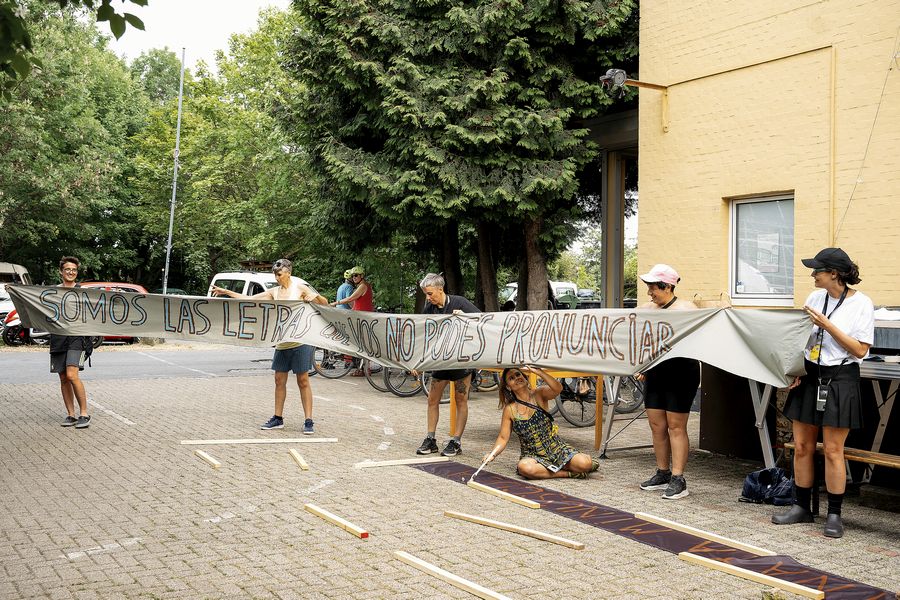Practicing the Lumbung: An Overview of documenta 15 in Pictures, by Alejandra Villasmil
。。。English translation below 。。。
La historia está plagada de capítulos sombríos donde los intereses geopolíticos y económicos terminan por incidir en la libre expresión cultural. En los casos más complejos, terminan en censura y autocensura. Desde este sur global, solo basta mirar los casos de Cuba y Venezuela.
Lo acontecido en la última edición de documenta se inserta precisamente en este juego del poder político, que tristemente ha acabado por socavar el derecho a la manifestación artística de un grupo de participantes de entre los 1.500 que provienen, casi exclusivamente, de Asia, África y Latinoamérica. Una maniobra del status-quo que ha sacudido e indignado a parte de los artistas y a los organizadores artísticos de este importante evento quinquenal, cuyo público validador ha venido siendo por años el circuito del arte instaurado desde el norte y occidente.
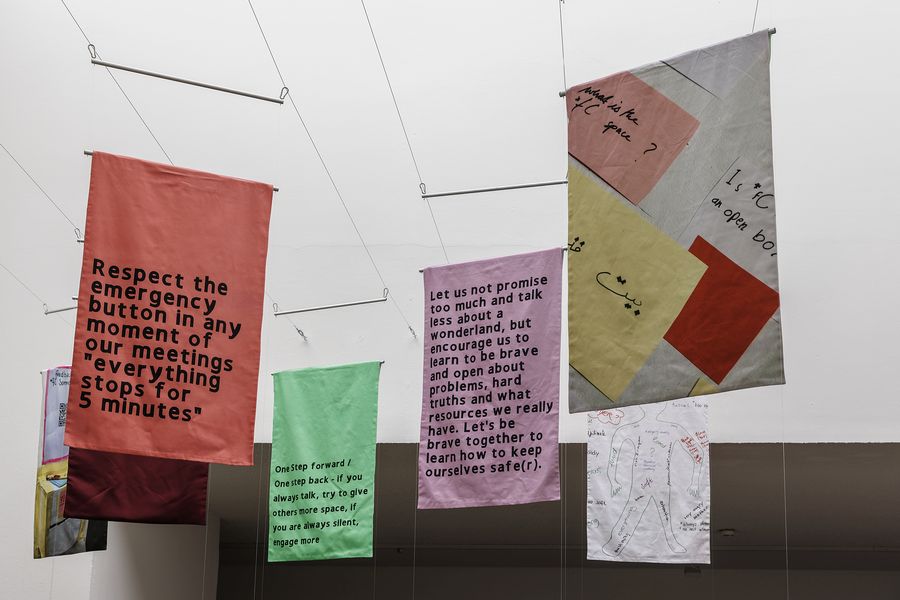
Quienes hemos seguido el desarrollo de estos acontecimientos somos testigos, una vez más, de aquellas dinámicas que mantienen al centro los intereses de lo establecido. Lo que vino a demostrar esta edición de documenta, curada por el colectivo artístico indonesio ruangrupa, es que plantear un cambio de paradigma en los modos de pensar y hacer desde el Sur Global sacude el piso del Norte Global: amenaza sus estructuras, desde el imperante y conservador mundo del arte hasta el entramado de relaciones diplomáticas globales.
Frente a quienes se autoproclaman la última palabra, el temerario gesto de ruangrupa alerta del deseo histórico y la necesidad actual de un modelo más justo, colaborativo y sustentable. La ética en curso debe cambiar.
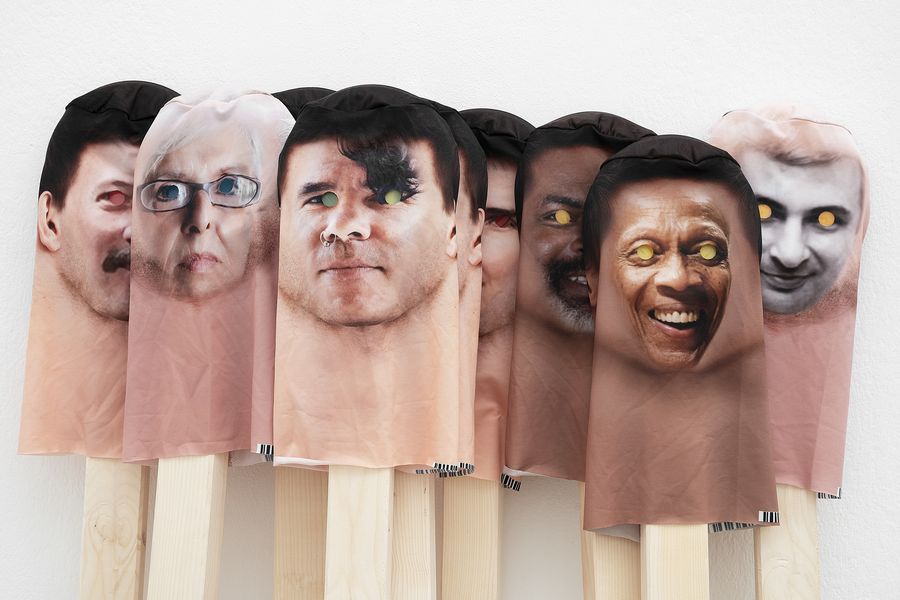
Con su metodología de trabajo basada en el lumbung –uno de los tantos conceptos que ruangrupa introduce en esta edición de documenta para, precisamente, sacudir los moldes, y que se traduce en el compartir y en la generosidad en tiempos críticos-, el colectivo nos informa -o nos recuerda- que nuestra opción para revocar esta anómala coexistencia planetaria es reconocernos como aliados.
Si nos detenemos en otros conceptos que ruangrupa trae a esta documenta, notamos en todos ellos un llamamiento insistente a lo que como colectividad debemos y podemos transformar si queremos salir del adormecimiento sistemático implementado por los discursos y el ejercicio del extractivismo, el racismo y otras formas de colonización e instrumentalización de los cuerpos, la tierra y el pensamiento.
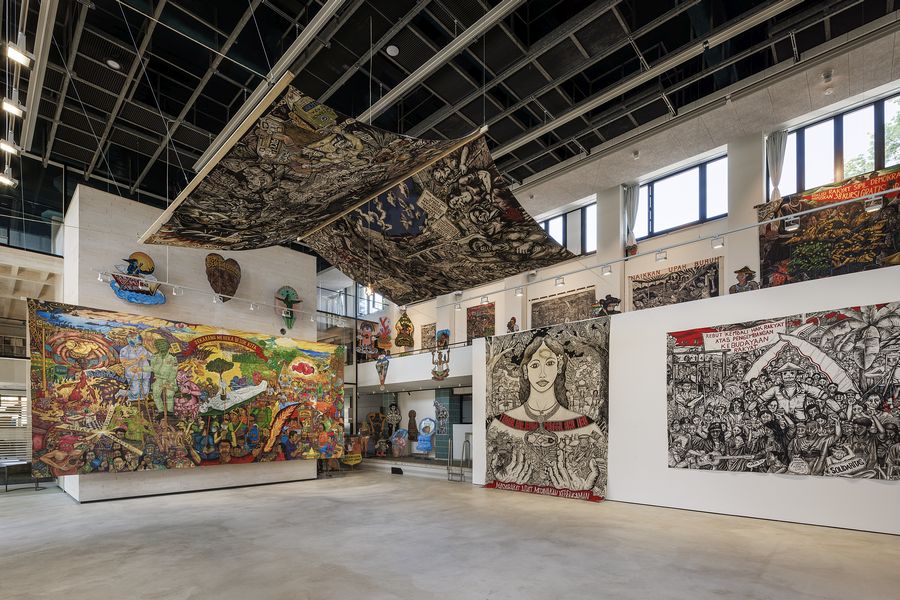
En primer lugar, ruangrupa y el Equipo Artístico de documenta* no consideran a Kassel como “sitio” de una exposición. En cambio, la ciudad se entiende como un ekosistem (ecosistema), una malla de contextos sociales en los que documenta emerge y crece. Ekosistem describe estructuras de redes colaborativas a través de las cuales se comparten y vinculan conocimientos, ideas y acciones, y es también como se ha articulado la participación artística, donde desde el llamado de ruangrupa y los 14 miembros del lumbung se fueron realizando invitaciones progresivas a otros artistas y colectivos, como la onda expansiva que se crea cuando se tira una piedra al agua.
Pero la noción central de esta radical metodología de trabajo e interrelación es, como decíamos, el lumbung, término indonesio para ‘granero de arroz comunal’, donde se almacena el excedente de la cosecha para beneficio de la comunidad en tiempos difíciles. Como modelo artístico y económico, lumbung tiene sus raíces en principios como la colectividad, el intercambio comunal de recursos y la asignación equitativa. De este modo, el proceso artístico de documenta no viene dictado por ruangrupa a la manera de una curaduría vertical tradicional, sino que se va construyendo colectivamente. La autoría individual se diluye.

No se trata, por tanto, de un evento fijo, estático, sino uno que ha venido mutando a lo largo del tiempo con organicidad y espontaneidad. Por eso tampoco es una exposición bajo el modelo acostumbrado. Si bien hay muchas obras para ser miradas y admiradas, los artistas deciden qué tipo de uso les dan a los espacios que le han sido designados. Algunos organizan talleres, conversaciones o proyecciones de películas, otros los han convertido en lugares de conversación, alimentación y descanso. Esta documenta cierra la brecha entre arte y vida, al cuestionar la institucionalización y comercialización de las manifestaciones artísticas.

Más que un concepto, lumbung es una práctica conciente de ser-estar, que no solo se activa en los 100 días de documenta, sino que tiene un historial en el propio recorrido de ruangrupa, así como una perspectiva a futuro: el lumbung.space. Esta plataforma virtual, construida de forma colectiva por artistas y colaboradores que practican los valores del lumbung, seguirá su curso en el tiempo, alimentándose de reflexiones y contenidos digitales como este artículo y otros por venir.
Aquí presento un recorrido visual por apenas algunos de los 1.200 proyectos y eventos de documenta fifteen anclados en lo sensible, lo local, el activismo, la pedagogía, la generosidad, lo colectivo y el compartir. La presente edición, que se despliega en 32 espacios de Kassel, termina este 25 de septiembre, pero las ideas, acciones y valores que hacen de lumbung una forma radical de operar dentro del sistema-arte, y en los modos de convivencia, perdurarán más allá de la sombra del escándalo.
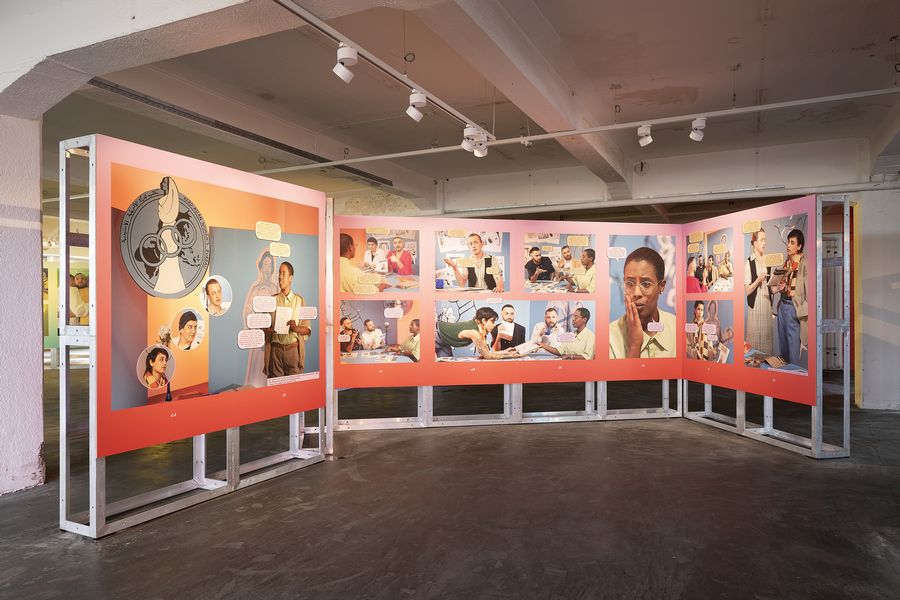
。。。
History is full of dark chapters where geopolitical and economic interests end up affecting free cultural expression. In the most complex cases, they end up in censorship and self-censorship. From this global south, just look at the cases of Cuba and Venezuela.
What happened in the last edition of documenta is inserted precisely in this game of political power, which sadly has ended up undermining the right to artistic manifestation of a group of participants among the 1,500 that come, almost exclusively, from Asia, Africa and Latin America. A maneuver of the status-quo that has shaken and outraged part of the artists and the artistic organizers of this important five-year event, whose validating public has been for years the art circuit established from the North and the West.
Those of us who have followed the development of these events are witnesses, once again, of those dynamics that keep the interests of the established at the center. What this edition of documenta, curated by the Indonesian art collective ruangrupa, came to demonstrate is that posing a paradigm shift in the ways of thinking and doing from the Global South shakes the floor of the Global North: it threatens its structures, from the prevailing and conservative art world to the web of global diplomatic relations.
In the face of those who proclaim themselves the last word, ruangrupa’s reckless gesture alerts to the historical desire and current need for a more just, collaborative and sustainable model. The current ethics must change.
With its work methodology based on lumbung – one of the many concepts that ruangrupa introduces in this issue of documenta to precisely shake the molds, and that translates into sharing and generosity in critical times – the collective informs us – or reminds us – that our option to revoke this anomalous planetary coexistence is to recognize ourselves as allies.
If we dwell on other concepts that ruangrupa brings to this documenta, we notice in all of them an insistent call to what we as a collectivity must and can transform if we want to get out of the systematic numbness implemented by the discourses and exercise of extractivism, racism and other forms of colonization and instrumentalization of bodies, land and thought.
First of all, ruangrupa and the documenta* Artistic Team do not consider Kassel as the “site” of an exhibition. Instead, the city is understood as an ekosistem (ecosystem), a mesh of social contexts in which documenta emerges and grows. Ekosistem describes collaborative network structures through which knowledge, ideas and actions are shared and linked, and it is also how artistic participation has been articulated, where from the call of ruangrupa and the 14 members of the lumbung, progressive invitations to other artists and collectives were made, like the shockwave created when a stone is thrown into the water.
But the central notion of this radical methodology of work and interrelation is, as we said, the lumbung, the Indonesian term for ‘communal rice granary’, where the surplus of the harvest is stored for the benefit of the community in difficult times. As an artistic and economic model, lumbung is rooted in principles such as collectivity, communal sharing of resources and equitable allocation. Thus, documenta’s artistic process is not dictated by ruangrupa in the manner of a traditional vertical curatorship, but is collectively constructed. Individual authorship is diluted.
It is not, therefore, a fixed, static event, but one that has been mutating over time with organicity and spontaneity. That is why it is not an exhibition under the usual model either. Although there are many works to be seen and admired, the artists decide what kind of use they want to make of the spaces they have been assigned. Some organize workshops, conversations or film screenings, others have turned them into places for conversation, food and rest. This documenta bridges the gap between art and life by questioning the institutionalization and commercialization of artistic manifestations.
More than a concept, lumbung is a conscious practice of being-being, which is not only activated in the 100 days of documenta, but has a history in ruangrupa’s own journey, as well as a future perspective: the lumbung.space. This virtual platform, built collectively by artists and collaborators who practice the values of lumbung, will continue its course over time, feeding on reflections and digital content such as this article and others to come.
Here I present a visual tour of just a few of the 1,200 documenta fifteen projects and events anchored in the sensitive, the local, activism, pedagogy, generosity, collectivity and sharing. The current edition, which unfolds in 32 spaces in Kassel, ends this September 25, but the ideas, actions and values that make lumbung a radical way of operating within the art-system, and in the modes of coexistence, will endure beyond the shadow of scandal.

